They Stood Proud and Strong
"We grunts never knew, one day from the next, where we were or what we were accomplishing. The mountains, valleys, stinking rice paddies, and frozen mountains all seemed the same to us. We were living and dying in our own violent little world." - Marine serving during the Korean War with 3rd Battalion, 5th Marines
The Darkhorse Battalion
In a remarkable five-month period, 3rd Battalion, 5th Marines (3/5) would make history. They would fight at the Pusan Perimeter, be the first to land at Inchon, help liberate Seoul, and play a key role in one of the Marine Corps epic engagements: The Battle of Chosin Reservoir.
Their hard-charging leader, Colonel Robert D. “Bob” Taplett, a 6'2" strapping World War Two veteran who "cared deeply about his men," would earn a Navy Cross, two Silver Stars, and the Legion of Merit during his time in Korea.
From August to December 1950, the men of “Darkhorse” Battalion (nicknamed in reference to Taplett’s radio call sign “Darkhorse Six") distinguished themselves as fearless warriors, loyal brothers in arms, and, above all, dedicated Marines.

Taplett is awarded a Silver Star for his actions on Wolmi-do. (PC: USMC)
The "Yellow Leggings” Defend Pusan
As members of 1st Marine Provisional Brigade, or the "Fire Brigade," as it was called by the media, the Marines of 3/5 left San Diego on July 14, 1950, and three weeks later landed at Pusan, South Korea. They were immediately sent to the Pusan Perimeter to help defend the last toehold of freedom on the Korean peninsula.
Taplett, a no-nonsense South Dakota native who had grown up during the Depression and joined the Marine Corps in 1940, spent the next four weeks leading his Marines as they attacked and counterattacked wherever the Army needed them. By the end of the first week of September, the 1st Provisional Brigade had lost over 150 men, with more than 700 wounded. The North Koreans had suffered an estimated 9,900 killed and wounded.
The “yellow leggings,” as the North Koreans called the Marines, had played a decisive role in the defense of Pusan.
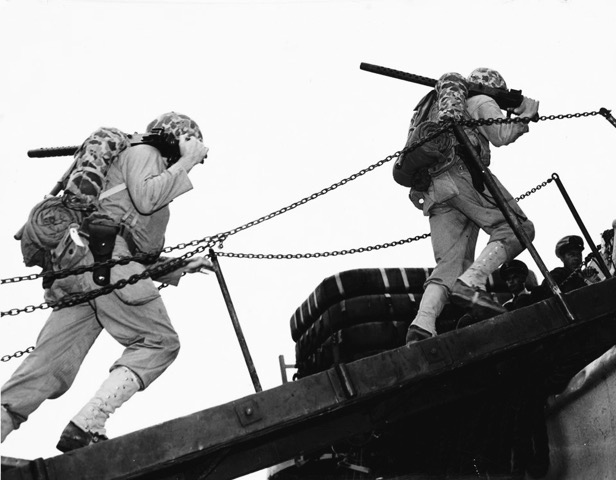
Marines leaving San Diego for South Korea. Notice the “yellow leggings.” (PC: USMC)
But stopping the North Koreans had taken its toll. Recalling the terrible plight of South Korean refugees, Taplett wrote in his book, Dark Horse Six:
We came upon one of the most horrific sights I witnessed in Korea. A party of 30-40 women, children and old men fleeing from the carnage of war had been caught in a cross fire. Retreating Army tanks had run over the bodies, grinding up the remains in their treads.
Within days of leaving Pusan, Taplett and his men were once again on Navy ships, this time headed for the largest amphibious operation of the war: the Inchon Landing.
That’s It; Let’s Go Get A Cup Of Coffee
In the early morning hours of September 15, 1950, D-Day for the Inchon invasion, the Marines of 3/5, now part of 1st Marine Division, enjoyed what would be their last hot breakfast for weeks. They then climbed into waiting landing craft and began barreling their way towards Wolmi-do, a strategically-located island in Inchon harbor.
With the US Navy's big guns pounding the island and Corsairs flying overhead “strafing the beach with guns and bombs and hot empty shell casings falling on them,” Taplett and his men hit the beach and immediately went into action. Blowing up bunkers, blasting caves, and destroying pockets of enemy resistance, they secured the island in less than an hour.

3/5 Marines raise the American flag on Wolmi-do, while North Korean prisoners are guarded by onlooking Marines. (PC: USMC)
When General Douglas MacArthur, watching safely from his command ship in the harbor, saw Taplett’s men raise the American flag over Wolmi-do, he exclaimed, “That’s it; let’s go get a cup of coffee.”
In his official radio message to the invasion fleet he said, "The Navy and Marines have never shone more brightly.” For Taplett, it would prove to be one of the proudest moments of his Marine Corps career.
By the end of the day, Inchon was under Marine control.
With Heavy Hearts
Over the next two weeks, the Marines of 3/5 made their way to Seoul and in vicious street-to-street, house-to-house fighting secured the war-torn city. On September 27, Taplett’s Marines again raised the American flag, this time over the South Korean Capitol building.
Taplett had pushed his Marines hard. Since landing at Wolmi-do, his battalion had killed 1,200 North Korean soldiers and captured more than 590. But their success had come at a high price.
“With heavy hearts,” Taplett later wrote, "we added up our lost comrades . . . and mourned the loss of four company commanders and fifty-four enlisted men killed in action (KIA) and seventeen officers and 289 Marines wounded in action (WIA)."
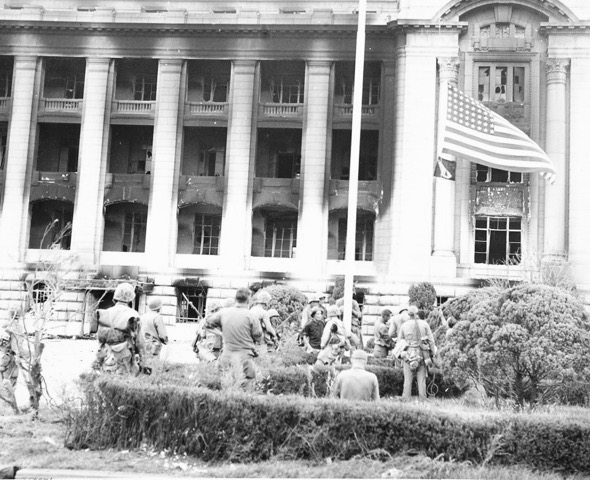
Col. Taplett’s Marines raise the flag in Seoul, September 27, 1950. (PC: USMC)
A Frozen Bloody Hell
By November, the Marines had made their way to the Chosin Reservoir, a frozen lake deep in the snow-covered, wind-swept mountains of North Korea. Taplett and his men spent Thanksgiving day, November 23, eating frozen turkey dinner, with all the trimmings, and hoping they'd be home by Christmas, as MacArthur had promised.
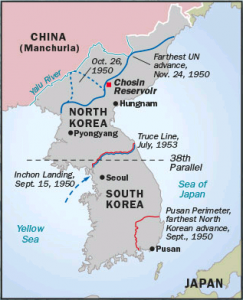 But on the night of the 27th, the Chinese attacked in force. Thirty thousand Americans were surrounded by 120,000 Chinese.
But on the night of the 27th, the Chinese attacked in force. Thirty thousand Americans were surrounded by 120,000 Chinese.
“Our winter wonderland changed abruptly to a frozen bloody hell,” Taplett wrote.
With temperatures plummeting to 30 below and Siberian winds constantly buffeting their positions, the Marines, along with soldiers from the US Army's 31st Regimental Combat Team and Royal Marines of 41 Commando, spent the next four days and nights fighting against wave after wave of attacking Chinese.
Outnumbered and trapped, the UN forces were ordered to retreat. Taplett’s battalion, leading the initial breakout from Yudam-ni to Hagaru-ri, two small towns on the west side of the Chosin Reservoir, suffered heavy casualties.
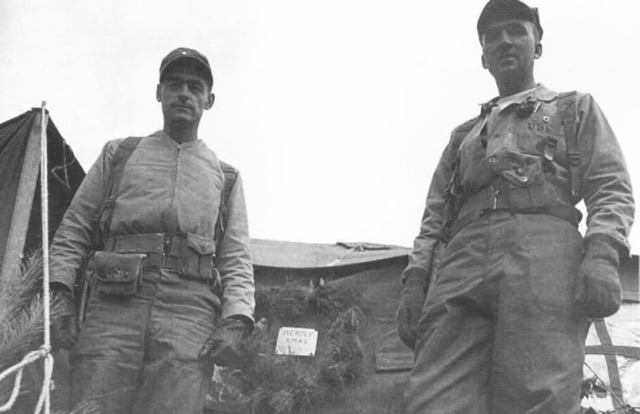
Taplett with his executive officer, Major John Canny, who would die two weeks after the photo was taken. (PC: USMC)
“Frozen pineapple juice and Tootsie Rolls,” Taplett remembered, "would be our only sustenance on our way to Hagaru-ri.” Fighting and marching for four straight days, the last elements of 3/5 entered Hagaru-ri on the afternoon of December 4.
Of the nearly 1,800 Marines that had left Yudam-ni, only 320 were combat ready when they reached Hagaru. The rest were dead, wounded, or missing.
Noticing a “hideously disfigured” Marine on the side of the road, Taplett, who had eight weeks earlier said goodbye to his pregnant wife and two young children, wrote, “I’ll never forget his bloody frozen clothing and his bloody face, green with frozen pus, one eyeball partially out of its socket."
The shocking images of death, destruction, and suffering stayed with Taplett the rest of his life.
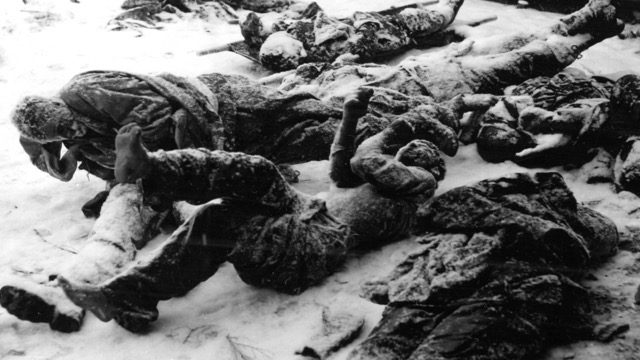
Thousands of soldiers and Marines were declared "missing in action" at the Battle of Chosin Reservoir. (Photo credit: US Marine Corps)
A Supreme Test Of Leadership
“The sheer exhaustion from days of continuous heavy fighting,” Taplett recalled, affected every Marine. “The will to fight and even live required a supreme test of leadership at all levels. Our Marine Corps training and esprit was given its severest test.”
But in the end, the Marines prevailed, making it 70 miles down a winding, single-lane, snow-covered road, with Chinese firing at them, to the port of Hungnam, where Navy ships waited to evacuate them.
The exhausted colonel told USA Today, “From November 27 to December 10, we were in almost constant combat. I don't think I slept two hours the whole time.”
He was so tired he had almost forgotten it was his birthday. He was 32.
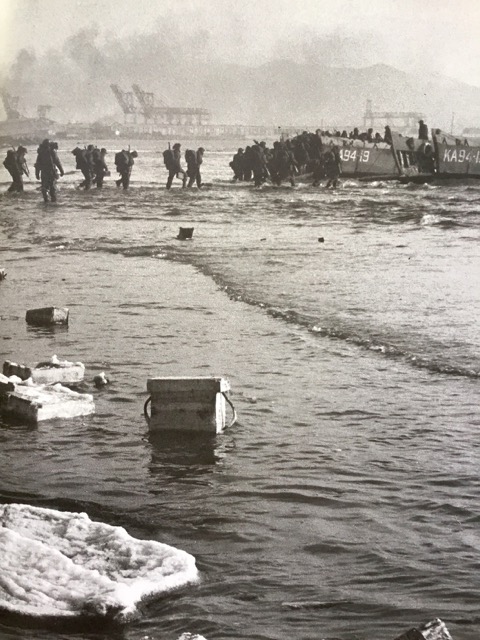
Marines evacuating at Hungnam, Dec. 1950 (PC: David Douglas Duncan)
Postscript
Reminiscing about his time in Korea and the brave young men he served with, Taplett later said:
The members of 3/5, whether Marines or Navy men, youngsters fresh out of high school or college graduates, reinforced the Leatherneck code of toughness and discipline, adding new luster to the Corps’ time-honored motto, “Semper Fidelis." . . .
They stood proud and strong and laid their lives on the line to defend their Corps and to save the western world from Communist aggression. They were men of honor, valor, integrity and loyalty, "the Few Good Men."
Colonel Taplett returned to the States in February 1951. His wife Pat, two daughters, Claire and Christine, and newborn son, Robert, greeted him upon his arrival. The couple had three more children, Marty, Martin, and Margot, before Taplett's retirement from the Marine Corps in 1960.
Taplett’s son, Martin Ross, remembers retired Marines saying, “If your Dad had stayed in the Marine Corps he would have made Commandant.”
"He was a humble, calm, thoughtful and loving man that always wanted the best for those around him,” Ross recalled. "He loved his family and God and was a faithful Catholic."
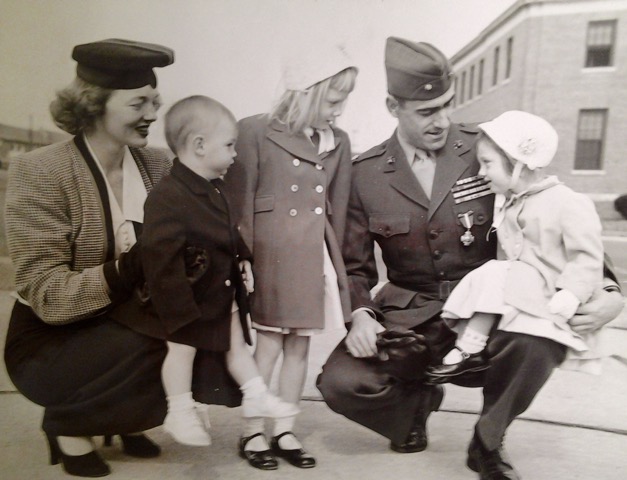
Bob Taplett and his wife Pat, with their first three children, Claire, Christine, and Robert circa 1952. (PC: Ross Taplett)
His wife of 58 years later told a reporter, “He loved being a Marine.” Joking about her husband she added, "Some people called him a poor man's Gregory Peck, but I always said he was a cross between Tyrone Power and Robert Taylor."
Robert Taplett died on December 17, 2004, at the age of 86. He was buried at Arlington National Cemetery with full military honors.
Author's Note
As a Marine veteran living in Seoul for the past four years, I have seen firsthand the tremendous impact Col. Taplett, the men of 3/5, and all our brave soldiers, sailors, airmen, and Marines made on the Republic of Korea and its freedom-loving citizens.
On July 27, 1953, the Korean War ended with the signing of an armistice. During the three years of fighting, millions of people perished, and almost every city, town, and village on the peninsula was damaged or destroyed.
But thanks in large part to the sacrifices made by hundreds of thousands of Americans from rural towns like Tyndall, South Dakota, big cities like Washington, New York, and LA, and countless communities and neighborhoods across our great nation, South Korea was saved from Communism.
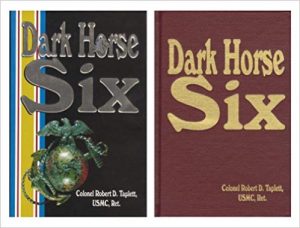 In the introduction to his book, Dark Horse Six, Col. Taplett pays tribute to these remarkable young men and praises them for their loyalty, dedication, and courage.
In the introduction to his book, Dark Horse Six, Col. Taplett pays tribute to these remarkable young men and praises them for their loyalty, dedication, and courage.
The quote at the beginning of this blog comes from Taplett’s introduction and is a perfect example of how proud he was of his “grunts,” the men who with their sweat, blood, and tears helped keep Korea free.
As a Marine infantry officer myself, I understand and admire Col. Taplett’s love for his Marines. And I am in awe of what they accomplished together. We owe them so much!
I would like to thank the Taplett family, particularly Ross and Pam Taplett, for their support in researching and writing this blog and for sending me a signed copy of Dark Horse Six.
Top/Feature picture: Marines at Chosin Reservoir (PC: USMC)

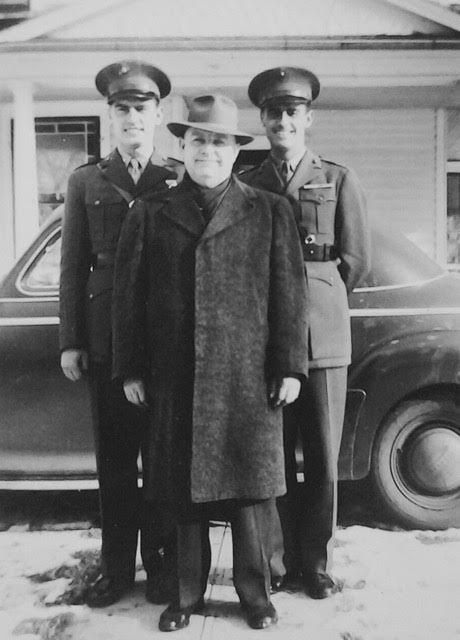
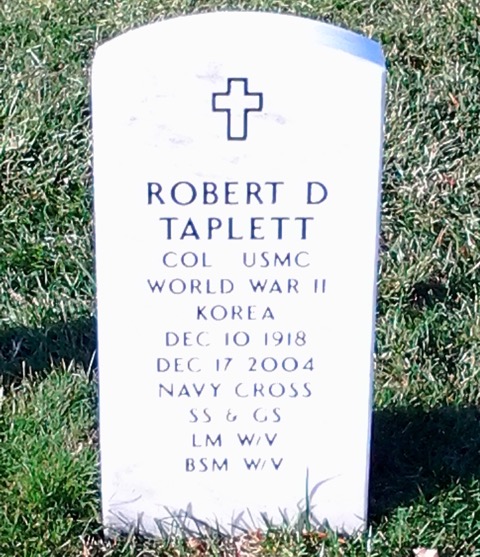
Richard Miller was in G co. 3/5. My cousin (deceased) Rogene H Kilpatrick was in H Co. They never met after the war, but the connection opened a grand friendship among my family and the Millers. I have written blog posts of this Consumate Professional at incountry.blogspot.com. I often pass aling a card printed with an “Irish Blessing” from ussocallahan.org shipmates. I am preparing a similar card so Dick can hand out a connection to his own history. It will boldly say “Semper Fi” and in response to the typical thank you for your service, says “YOU are worth it.” … But.. i am having trouble locating the 3/5 emblem used in Korea. I hope someone can send me a picture. His card will akso show 3 purple hearts. All three came the year after Chosin. He is an amazing man. I hope this note sparks a connection for him.
Thanks for honoring these Marines who served in Korea. We owe them so much and will never forget their sacrifices.
Hope that you can find the emblem used in Korea.
Look forward to checking out your blog.
Thanks for commenting, Vic.
These are the kinds of stories and stout men our youth need to be introduced to today, men whose convictions were forged incrementally in the demands of training and tested exponentially in the field pf battle. Next to mail call (during boot camp), my ears wee perked and my zeal piqued by hearing DI’s brag on the men they fought alongside, the Navy Corpsmen who bandaged their wounds and the gallant sacrifices thousands made in places like Tarawa, Iwo Jima and Belleau Wood.
Thanks for reading and commenting on the blog, Michael.
What these Marines did is a proud part of the Corps’ history, and their stories need to be shared- as you rightly say.
Semper Fi!
Ned, another well written story from the Korean War. I believe Col. Taplett had natural God Given leadership qualities. He cared for his men. He was right there with his men. We hear a lot about Col. “Chesty” Puller, and I’m not discounting either leader. But we don’t hear about Col. Taplett. These kinds of stories are valuable to pass the legacy on concerning Korean War service and sacrifice by the Armed Forces of the US and UN, so it won’t be forgotten, and vanishes into the silent din of the past.
Thanks for your thoughtful comments, Doug.
Like you, I believe Col. Taplett had natural leadership qualities, and I’m glad I was able to share his story.
Always appreciate your great feedback.
Great story Ned, as usual —- I’m a proud member of I/3/5. Pat Finn
Thank you, Pat. I’m glad you enjoyed it.
You were part of a history-making battalion, and I salute you! So glad that we met and you shared your story with me.
It’s interesting that I’ve now written about the battalion commander and you – two great men!
Hello to all and Semper Fi from my Dad,
Sgt Major Albert Meringolo, my Dad just recently passed away on 25 February 2020. He was a member of the proud Darkhorse 1/3/5. I am desperately trying to find a copy of Dark Horse Six. I am
Not saying this wonderful publication is not worth it, but the cost on line is near, at, or over $100. If anyone has any ideas of where I can find this book, please email me at tmeringolo71@gmail.com.
Thank you and God Bless the US Marine Corps.
Tom Meringolo
I salute your dad for his service with Darkhorse 1/3/5! He was one of the Greatest Generation, and we owe him and all those Marines so much.
Hoping someone can help you find a copy of the book. We’ll keep our eyes open as well.
Thanks, Tom, and Semper Fi!
Very well written.Most of the American people never knew what our guys went thru. God bless all of my comrades
Thanks for reading the blog and commenting, Robert. Appreciate your kind words and support.
I enjoyed writing this and hope to help more people gain an understanding of what these men went through.
When did you serve?
Such a great article Ned. NowI understand where the Recruiters obtained the recruiting ad “The Marines are looking for a few good men”. They were using that when I was an AFEES Commander in the 1970-72 time frame.
Thanks for reading and commenting, Travis. Glad you liked the article and you’re right- the “few good men” slogan has been around a long time!
I really enjoyed reading Col. Taplett’s book and learning more about him and the men of 3/5. It was great getting to know his son as well.
We always appreciate your feedback.